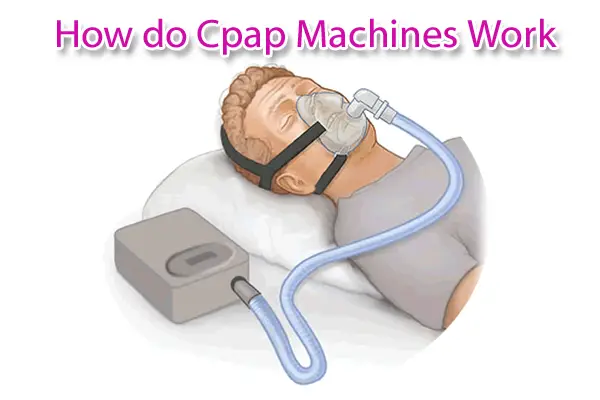Sleep apnea is a sleep disorder that affects at least 20 million Americans.
It is characterized by brief pauses in breathing that occur repeatedly throughout the night, leading to feelings of fatigue and reduced daytime performance.
A common recommendation for treating this condition is using a Continuous Positive Airway Pressure (CPAP) machine, otherwise known as a sleep apnea machine. Though, how does a sleep apnea machine work?
A CPAP or sleep apnea machine delivers pressurized air through a mask worn over the nose and/or mouth during sleep.
The mask is connected to tubing that carries the air from the machine. The pressurized air helps keep your airways open, allowing you to breath easily as you sleep and reducing the number of pauses in breath associated with obstructive sleep apnea.
I’m Aaron, sleep expert. Let’s dive into the technical aspects.
How Does the Sleep Apnea Machine Work? The Parts
- Pressure Generator: This component generates the pressurized air. Depending on the model of CPAP machine you have, it may be adjustable so that you can set the amount of pressure that works best for you.
- Humidifier: Many models come with an optional humidifier attachment, which adds moisture to the air delivered from your CPAP machine, making it easier and more comfortable to breathe during sleep.
- Mask: Most models come with various types of masks for different preferences—nasal pillows, nasal masks, full face masks—that are all connected to a tube which sends pressurized air into your lungs while you’re sleeping.
- Tubing: The tubing connects your mask or nasal pillow device securely with your CPAP machine so that regulated amounts of pressurized air flow continuously while you’re asleep.
When used correctly and consistently, a CPAP or sleep apnea machine can help improve symptoms like snoring and fatigue due to longterm breathing pauses while asleep.
Self-help accessories like chin straps can also help patients get better results if they have trouble keeping their mouths closed while wearing their CPAP mask.
If you struggle with frequent waking due to untreated obstructive sleep apnea, then consulting with your family doctor or ENT can help determine if using a CPAP or BiPAP is right for you. They can determine how much pressure should be applied depending on your needs and situation.
Are There Different Types of CPAP Machines?
Yes. There are many brands and types. CPAP (Continuous Positive Airway Pressure) machines are the most common type of sleep apnea machine. However, there are others, but the principle remains the same. They all deliver air from a machine to your mask.
These are:
- Fixed Pressure CPAP Machines: The most common. These machines deliver a constant pressure throughout the night.
- Auto-Adjusting CPAP Machines: These machines automatically adjust the pressure based on your breathing patterns.
- BiPAP (BiLevel Positive Airway Pressure) Machines: These machines deliver two levels of air pressure—one for inhalation and one
- Adaptive Servo-Ventilation (ASV) Machines: Those with central sleep apnea can take advantage of this machine, which can work to keep airways open by providing a regulated breath when needed.
How Often Does a CPAP Machine Need Cleaned?
Cleaning a CPAP machine is important for maintaining its effectiveness and hygiene.
It is recommended that the mask, tubing, and humidifier chamber be cleaned at least once a week with warm water and mild soap.
The machine itself should be wiped down with a damp cloth every few days. Additionally, the filter should be changed regularly according to the manufacturer’s instructions.
It is also important to check the air pressure settings on your CPAP machine regularly.
The settings should be adjusted according to your doctor’s instructions, and if you experience any discomfort or difficulty breathing while using the machine, it is important to contact your doctor right away.
Finally, it is important to remember that a CPAP machine should not be shared with anyone else.
Each person has their own unique breathing patterns and needs, so it is important to use your own machine.
Are There Alternatives to CPAP machines?
Yes. One alternative is an oral appliance, which is a custom-fitted device that fits in the mouth like a sports mouth guard. This device works by repositioning the lower jaw and tongue to keep the airway open during sleep.
Another alternative is positional therapy, which involves sleeping on your side instead of your back. This can help reduce snoring and improve breathing during sleep.
Finally, surgery may be an option for some people with sleep apnea. Surgery can involve removing excess tissue from the airway, or implanting a device to keep the airway open.
Conclusion
The sleep apnea machine is a highly effective treatment for those suffering from sleep apnea.
It works by delivering a steady stream of air to the patient’s airway while they are sleeping, which helps keep it open and prevents pauses in breathing.
The machine also monitors the patient’s breathing patterns and can adjust the pressure as needed.
With proper use and maintenance, this device can help improve sleep quality and reduce the signs and symptoms of sleep apnea.
Additionally, there are other alternatives to CPAP machines that may be suitable for some patients.
It is important to speak with your doctor before beginning any treatment for sleep apnea. They can help determine the best course of action and provide guidance on how to properly use and maintain a CPAP machine.
Additionally, they can discuss other alternatives that may be suitable for you. With the right treatment, it is possible to improve sleep quality and reduce the symptoms of sleep apnea.


